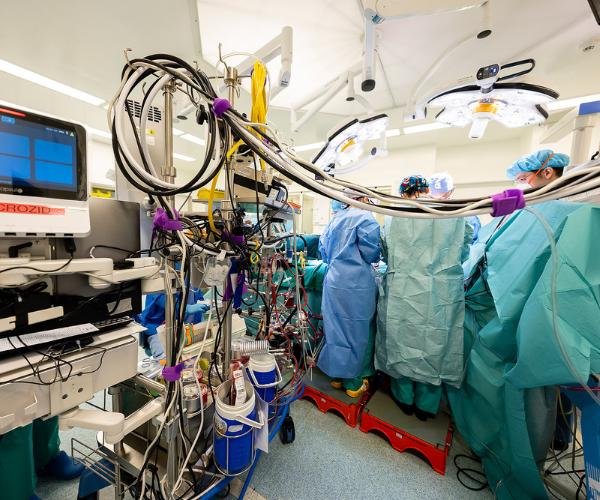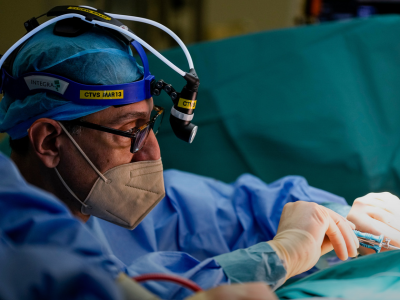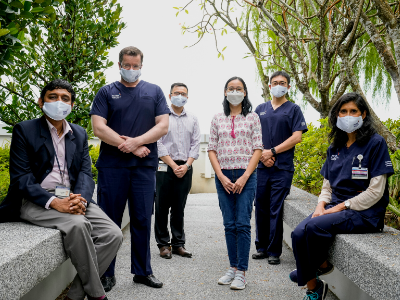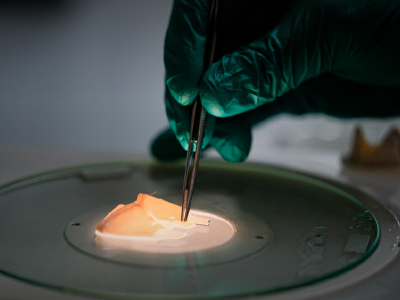Published on 8 May 2022
It's 9AM in the operating theatre (OT), and the surgical team is in full swing. The order of business this morning: a bypass surgery.
On the operating table, an array of tubes connects the patient to a complicated-looking setup of beeping monitors and whirring parts. The setup, called a heart-lung machine, drains the blood from the heart, cooling it in preparation for the surgery.
At 34 degrees Celsius, the surgeon is ready. "Pump down," he says. "Clamp."
Through one of the tubes, a chemical solution is pumped into the patient's system. And a few moments later, the intermittent beeping from the cardiac monitor ceases. The patient flatlines.
"Heart arrested," replies the perfusionist, from behind the heart-lung machine.

Being a patient’s heart and lungs
Of course, this is just a regular part of the job for a perfusionist.
Part of the cardiac surgical team, perfusionists operate the heart-lung machine. This machine does the work of the patient’s heart and lungs, allowing the organs to rest during procedures like open-heart surgery.
But for such a procedure to be done, the perfusionist must first force the heart to stop.
"During the surgery, we need the heart to be still and quiet, so the surgeon can work on it,” said Ms Nancy Huang, Senior Perfusionist at the National University Heart Centre, Singapore (NUHCS). “So the heart has to be stopped and drained.”
How this works: a cold strong potassium solution is administered to the patient’s heart through a catheter. This solution induces the heart to stop beating. Separately, the patient’s body is cooled via an oxygenator that receives chilled water, lowering his or her body temperature and preserving the organ.
After the operation, the patient is then rewarmed, and the solution will be metabolised – “so the heart will start to beat again,” said Ms Huang.
As the key operators of the heart-lung machine, perfusionists are in charge of pumping and oxygenating the blood through the body. They also monitor the patient’s signs throughout the operation: checking the patient’s temperature, oxygen levels, blood pressure, and so on.
In a typical workday, perfusionists attend to about two to four cases, depending on the length of each operation. Some surgeries are fairly straightforward and may take between six and eight hours – but major surgeries may take significantly longer. “My record is 13 hours,” quipped Ms Huang.
Still, the work never gets routine. “Some of my friends ask me, do you ever feel numb to [the work]?” she said.
“But no. Every case is a different case…in cardiac, every day you see different situations, different scenarios. And you always need a plan A, B, and C.”
When every second counts
The work doesn’t stop in the OT, however. Perfusionists also have to deal with emergency patients facing acute respiratory failure – and in some cases, retrieve these urgent patients from other hospitals as well.
During these retrievals, perfusionists rely on ECMO (extracorporeal membrane oxygenation), portable heart-lung machines that can be ferried between hospitals. Weighing around 10kg excluding accessories, the machine is usually packed into a suitcase for easy transportation.
This is especially important as every second counts in a retrieval, which should take place in the shortest possible time, Ms Huang added.
“When it comes to life-saving [work], time is so limited for us,” she explained, adding that the team sometimes rushes from their homes to retrieve a patient. “Touch wood, in the next minute, I could be activated to retrieve a patient in Ng Teng Fong General Hospital.”

Even after the patient has been conveyed to the ICU, perfusionists still need to be on standby in case of any issues with the machine, Ms Huang said.
“We can even be called in the middle of the night if the machine alarms, and we have to get there in less than half an hour.”
“Luckily, Singapore is very small,” she quipped.
Challenge with purpose
This year will mark Ms Huang’s 28th year on the job – but she maintains that she enjoys the purpose and challenge that comes with being a perfusionist.
“When I first started my career in perfusion, it was really a struggle,” she said. “But day in and day out, when we see patients happily go home with their family, it’s really good news to us.”
She shared about a patient who was rushed to the hospital for an urgent operation after fainting during golf. “I was pushing the patient from the cath lab to the OT, and his wife and daughter were crying as they followed us,” she said.
“I felt so bad for them…but when we see [things like this], it makes us try even harder to save the patient’s life. Because we know the whole family is expecting [them] to recover.”
That patient eventually made it through, she added. But not every patient does – and more so than the complex cases and long hours, it is this part – losing patients – that is the hardest part of the job.
“Saving lives is really challenging. It’s almost like fighting against a god,” she said.
Still, the lives she helps save makes the challenge worth it in the end, said Ms Huang.
“The best feeling is when I see patients in the CTICU (Cardiothoracic Intensive Care Unit), sitting up, having breakfast, or even on the phone, talking to their family. It makes me so happy when I see [this].”
“As a perfusionist for so many years…I still think we’re not only helping the patients, we’re also helping the family.”
Click here to find out more or to join us as a perfusionist.
In consultation with Ms Nancy Huang, Senior Perfusionist, Department of Cardiac, Thoracic and Vascular Surgery, NUHCS.



